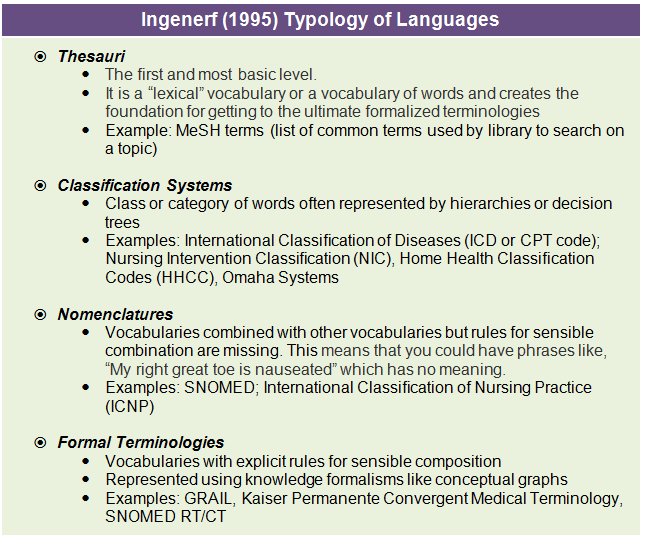Online Course
Nurs460 – Health Informatics for Registered Nurses
Module 7: Electronic Health Record Standards and Interoperability
EHR Standards
Learning Activity
Why are standards necessary?
Standards are the benchmarks or criteria against which people compare all types of things used in common. In general, we need standards for things like electrical outlets, the sizes of doors, the diameter of the gasoline nozzle, etc. Standards allow “things” to be re-used, giving a common interface for exchangeability.
Standards in General Language
Standards are necessary in language for similar reasons. For instance, there are significant semantic differences in words or language. Take the word cold. Does it mean sickness (I have a cold), temperature (I am cold), attitude (He is so cold to me), skill/ability (I have it down cold)? This is why language representation is so important. Trying to represent one specific meaning of such a simple word in a computerized system is VERY difficult. The computer cannot interpret meaning. It can only represent it as a word. This leaves it up to the individual reader to identify the meaning. This would be easy in a single instance, but in aggregate data, this presents a great deal of trouble, thus illustrating how truly difficult it is to build a solid and accurate electronic health record (EHR).
The meanings of words are based on several things, such as context, tone or intonation, geographical location of the speaker or the conversation, the social sphere in which the person resides, culture, etc. For example consider the phrase “strength of grasp”, which is often recorded in both premature infants and in stroke victims. In both cases, the phrase relays a common thought, but in each instance, the range of strong to very weak has a very different connotation. A strong infant could still be very much weaker than a weak adult. Consider also the word “tall”. Again, an extremely tall two year old will be a great deal shorter than Shaquil O’Neil.
Let’s discuss Florence Nightingale for a moment. She was the first informatician, the first health services researcher, the first proponent of evidence-based practice, and the first modern nurse. Nightingale said that comparable data provided several benefits, including, the ability to identify unnecessary deaths, determine the effectiveness of particular operations and treatments, ascertain the influence of the hospital upon outcomes, save life and minimize suffering, and improve the treatment and management of the sick. In order to have comparable data, a language must have several characteristics. What characteristics must language have to produce comparable data in health records?
Ingenerf developed a typology of languages. Ingenerf’s Typology originated from a foundation of library science and is a hierarchical structure for language representation. The formal definition is, “…four types of taxonomic vocabularies for healthcare based on the underlying structure and related knowledge representation formalism.” Again, the four types of vocabularies are hierarchical. They include thesauri; classification systems; nomenclatures and formal terminologies.

Standardized Nursing Languages
Nursing languages, classification systems and terminologies allow us to consistently capture, represent, access, and communicate nursing data, information, and knowledge. There are many nursing languages, formal and informal, but currently there isn’t one that meets the needs of all nursing specialties – yet!
Explore these links to learn more about nursing data sets and classification systems:
| Nursing Classification Systems and Data Sets | |
|---|---|
| NANDA Nursing Diagnosis |
CCC Clinical Care Classification |
| NIC Nursing Intervention Classification |
ICNP-UNLS International Classification for Nursing Practice (ICNP®) |
| NOC Nursing Outcomes Classification |
AORN-PND Perioperative Nurse Data Set |
| OMAHA | Patient Care Data Set |
Other Standardization Efforts
- This stands for Systemized Nomenclature of Human and Veterinary Medicine (SNOMED)
- Developed by College of American Pathologists to code findings from tissue specimens.
- This language has expanded into other areas of medicine and now includes clinical terminology (CT) under consideration for use in nursing.
UMLS – Unified Medical Language System
- This is not a vocabulary, instead a mapping system between major classification systems
- Focus on medical diagnosis, treatments, notes, and contains ANA approved systems
This website is maintained by the University of Maryland School of Nursing (UMSON) Office of Learning Technologies. The UMSON logo and all other contents of this website are the sole property of UMSON and may not be used for any purpose without prior written consent. Links to other websites do not constitute or imply an endorsement of those sites, their content, or their products and services. Please send comments, corrections, and link improvements to nrsonline@umaryland.edu.